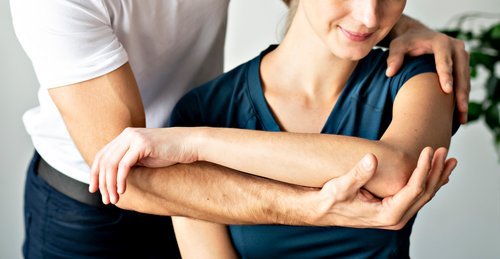Florence Charbonneau-Dufresne
Montreal physiotherapy
COMPLEX REGIONAL PAIN SYNDROME
. . . . . . . . . . . . . . .
What is Complex Regional Pain Syndrome?
It is a painful condition, usually post-traumatic, usually affecting the entire arm, but with more intense symptoms in the hand.
Patients with CRPS have intense and continuous pain, often burning in the arm, but not in a specific nerve territory.
It is constant, disabling and disproportionate to the initial injury.
It may be accompanied by a change in sensitivity, i.e., sensitivity is increased or there are neurological symptoms such as tingling or numbness.
There are also vasomotor changes, which translate into increased vasodilation, which means redness, shiny skin or swelling, usually on the top of the hand and in the fingers.
Increased sweating activity may also occur and is expressed by the presence of sweating in the hand.
There may be motor impairment, and therefore a decrease in the active mobility of the affected limb, usually in the fingers.
This syndrome is mainly found in the arm, but can also affect the leg.
. . . . . . . . . . . . . . .
What is the cause?
There is no known exact cause, but complex regional pain syndrome (CRPS) is mainly found in patients who have suffered a trauma to the arm or following immobilization.
For example, following the wearing of a post-fracture cast, CRPS can develop.
CRPS occurs more frequently in women than in men.
Among the potential causes, there is a functional modification of the sympathetic nervous system with a role for the peripheral and central nervous systems.
This means that there is no structural damage to the nervous system, but rather an imbalance, i.e. inhibition or hyperexcitability, which leads to all the symptoms mentioned above.
. . . . . . . . . . . . . . .
Fluctuations in symptoms
Pain is often increased by moving the arm or by manual treatment techniques.
Pain is also influenced by stress, fatigue, anxiety, intense exercise, temperature changes, holding the affected limb lower than the heart.
Heat and cold can also increase pain.
. . . . . . . . . . . . . . .
Types of CRPS
There are two types of CRPS.
In the first type, there is no nerve damage, so the nerves are intact.
Type 1 usually occurs after a trauma, such as a fracture.
In type 2 CRPS, there is nerve damage, but the pain is not limited to the territory of the nerve.
Therefore, patients have symptoms of peripheral nerve damage in addition to CRPS symptoms.
. . . . . . . . . . . . . . .
Treatment of CRPS
The treatment of CRPS is interdisciplinary, with the goal of pain reduction, functional recovery of the affected limb, and improvement of psychological status.
The reduction of swelling is a key factor in the effectiveness of treatment.
Adequate analgesic medication and prompt physiotherapy management yield better results, which is why it is important to consult your doctor quickly if you think you have these symptoms.
It is also important to start physiotherapy quickly, as active joint mobilization must be done quickly.
The physiotherapist may also apply electrotherapeutic modalities, such as TENS, to reduce pain.
This is a transcutaneous electrical current that inhibits pain receptors.
The physiotherapist may also recommend renting the device from a pharmacy so that you can use it at home.
The physiotherapist will also show you how to do contrast baths, alternating between immersing the arm in cold and warm water to try to reduce the pain.
It is also important to avoid not using the affected limb. It is therefore important to use the affected limb in the activities of daily life.
This will help normalize the nervous system and thus reduce its imbalance, which is the cause of CRPS.
Occupational therapy consultations are therefore recommended to help you adapt your daily activities so that you can continue to use your arm, but without overloading it and causing pain.
This medical condition is usually managed in a hospital setting rather than a private clinic and unfortunately, recovery is usually long.
. . . . . . . . . . . . . . .
Florence Charbonneau-Dufresne, Physiotherapist Ph.t
florence.charbonneau-dufresne@cliniquealtermed.com


